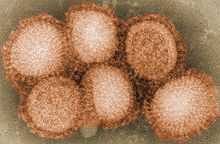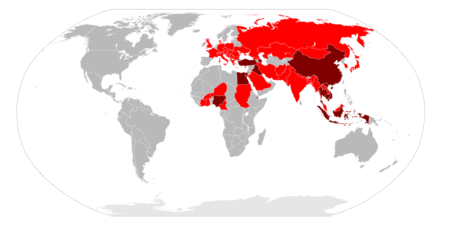2014 Bird flu outbreak in Kerala
| Influenza (Flu) |
|---|
 |
| Types |
| Vaccines |
| Treatment |
| Pandemics |
|
| Outbreaks |
| See also |
|
The 2014 Avian flu/Bird flu outbreak in Kerala is an incident occurred in some districts of Kerala, India in 2014. Avian flu is a disease caused to birds due to the infection of virus. The infection was caused by the H5N1 subtype of the Influenza A virus, which is the most fatal and deadly among the bird flu causing viruses. Though India has witnessed avian flu outbreaks earlier, it was the first incident of the kind in Kerala.
In 24 November 2014, the Kerala government confirmed the virus infection. The report was following the incidents occurred in the last two week were ducks were found dead near the backwaters of Kuttanad, Alappuzha then in its boarder district Pathanamthitta, and few places in Kottayam. The infection also kiiled chickens. Fortunately, there was no human infections reported.
Initial detection
Following the detection of bird flu virus in broiler chicken at a farm in Kumarakom, near Kottayam, a red alert has been sounded in Kerala’s Alappuzha, Pathanamthitta and Kottayam districts to restrict the movement of poultry and allied products. Earlier, tests had confirmed the virus in ducks in the three districts. The virus itself killed about 15,000 infected ducks in Kottayam and another 500 in nearby Alappuzha. Tests of samples of dead birds, conducted at The National Institute of High Security Animal Diseases Bhopal, had confirmed avian influenza virus (H-5 category) led to the death of about 15,000 ducks in Kuttanad in Alappuzha and Kottayam
Fear of human infections
In Alappuzha, 62 health teams had visited 11,729 houses and examined about 41,201 persons. As many as 6,750 persons were examined by 20 health teams in Kottayam while 2,234 persons were examined in Pathanamthitta. Apart from this, these persons were also given awareness about the diseases and the precautions that had to be taken. Health minister said that all the hospitals were well equipped for tackling any outbreak. Though there is enough stock of the medicine, that about 30,000 tablets reached the state on Friday. Apart from this, the government have placed orders for about 50,000 more tablets. Later it was detected the deadly H5N1 strain of virus was the cause of the avian flu outbreak.[1]
Government initiatives
Kerala chief minister Oommen Chandy called an emergency meet on 25 November 2014 to coordinate various departments including the Union health ministry to rush enough medicines. This was after a Bhopal-based laboratory confirmed that the mass deaths of ducks in Alapuzha were due to avian influenza or bird flu. 17,000 ducks perished in water-logged Kuttanad and surrounding areas in Alappuzha. The state animal husbandry department ordered culling of poultry in one-km radius of the affected area to contain the outbreak and distributing veterinary kits. Kumarakom Bird Sanctuary, home to a large of number of winged guests, is situated near the affected area. Awareness programmes was also launched and farmers and employees dealing with duck meat were asked to take precautions. Indian Medical Association (IMA) rushed a team to Alapuzha.[2] IMA state president Sreejith N Kumar said issued instruction to all private hospitals to take part in the government’s surveillance mechanism.
Indian ministry of agriculture submitted a report to the World Organisation for Animal Health (OIE) in Paris. The report said the animals died of an H5 strain of the flu virus but did not specify the exact variant. However OIE Director General Bernard Vallat told "India regularly reports cases of highly pathogenic avian influenza in wild and domestic birds. The problem in this case is that they have not been able to determine which variant yet, whether it is the same as the one in Korea and elsewhere." Since 2006 India has culled 6.4 million birds due to bird flu, Vallat said, adding that the latest outbreaks were not a particular cause for concern.[3]
H5N1 avian influenza virus was identified in poultry birds in Alappuzha, Kottayam and Pathanamthitta districts. So as a precautionary measure about two lakh birds mostly ducks decided to be culled in the villages starting from Tuesday on 25 November 2014 in the affected areas. And an intensive surveillance campaign had been launched in a 10 km radius around the area to ensure that the virus did not spread further. After culling it has been decided to burn the remains. Poultry owners, whose birds are going to be culled, will get a compensation of Rs.75 each for those which are two months old and Rs.150 for birds that over two months old.
Control measures adopted
Government imposed a ban on the sales of poultry products in and around the affected areas. These items must not be transported to other places too. Awareness campaigns were conducted in the three districts. The government educated the public and issue alerts in the affected areas. Booklets were distributed to people to make them aware of the threats that may arise due to this. The Health department and the Animal Husbandry department have opened 24 hour control rooms in all districts. Those wearing protective wears only will be allowed to enter the areas where mass culling of birds are taking place. Native people living around 10 km distance of the affected were advised to maintain strict dietary habits. They have been advised to desist from eating non-vegetarian food and the ministers urged them to follow the rules strictly. Health Minister V.S. Sivakumar advised "People should eat eggs and meat only after cooking them properly, no case of H1N1 has been reported till now and no need to be panic". Those involved in killing of the birds, have been given masks and aprons. It has also been decided that not a single bird will be allowed to be transported from the affected areas.[4]
Economic impact
The sale of bird meat, especially chicken, has seen a rapid decline. A retail chicken stockist indicated sales dropped 30-40 per cent on Tuesday on 25 November 2014, though the price was steady at Rs 82/kg. Broiler ducks were sold at Rs 300 each.[5]
Effects on economy of neighbouring states
Border areas in the state were on high alert following reports of the avian flu outbreak in Kerala. As the state government decided to imposed a total ban on the transportation of poultry and poultry products in trains from the neighbouring states. The ban was be enforced with immediate effect. Truckloads of chicken being transported by road from Kerala to Mangaluru were also been stopped at the border. The city is the largest consumer of chicken from Kerala. Bengaluru, on the other hand, gets its chicken from Tamil Nadu, Andhra Pradesh and local farms. Officials at the checkpost at Talapady confirmed that truckloads of chickens are not being allowed to enter Karnataka. Chicken traders in Mangaluru stopped buying chicken from Kerala-based suppliers.
The market, however, does not shown any fluctuations in supply so far and local stocks were sufficient to tide over demands for the next few days. The demand for chicken also dropped for a few days due to the three-day Subramanya Shashti festival in coastal areas. People celebrating the festival will not consume non-vegetarian meals till Saturday. Officials in the Animal Husbandry Department in Dakshina Kannada have sensitised the market about the avian flu outbreak in Kerala. Dakshina Kannada district is a good market for suppliers from Shivamogga, Hassan and Chikkamagaluru too. In case supplies drop from Kerala, they can always buy from those districts. However, that will cost them a little more than for stocks from Kerala.[6]
When the Kerala animal husbandry department on 24 November 2014, announced thousands of ducks in Alappuzha, Kottayam and Pathanamthitta districts died of bird flu, Poultry farmers in Tamil Nadu, especially those in Namakkal district, taken precautionary measures in the wake of bird flu outbreak in Kerala. Though there is no avian flu outbreak in Tamil Nadu. Across the state, the Tamil Nadu Poultry Farmers Association tightened the biosecurity in all farms. According to the biosecurity method, all persons working in poultry farms should wear separate clothes and be sprayed with a medicine (a mix of an anti-viral drug and salt). Similarly, persons coming from other places for business purpose should wash their hands and legs in the medicine before entering the farms. For vehicles transporting the chickens, all the wheels of the vehicles should be sprayed with the medicine. Some poultry farmers feared that egg exports would be affected due to the bird flu outbreak. However, National Egg Coordination Committee (NECC) sources allayed the fears saying egg exports would not be affected. "Countries like Oman, Afghanistan and Algeria are still importing eggs from India even after the World Organisation for Animal Health classified India as a bird flu affected country," NECC told.[7]
Parallel incidents
| Highly pathogenic H5N1 | |
|---|---|
 | |
| Countries that have reported deaths of poultry or wild birds linked to highly pathogenic H5N1 infection. | |
| Countries that have reported human cases of highly pathogenic H5N1 infection. | |
Germany, the Netherlands and Britain have been hit the same month by the H5N8 bird flu strain which devastated flocks in Asia, mainly South Korea, earlier the year but has never been detected in humans. The strain H5N1, which is fatal to humans caused the deaths of nearly 400 people and hundreds of millions of poultry after it spread from Asia into Europe and Africa in 2005–2006.
The first outbreak of avian flu in India was in the western state of Maharashtra in 2006. But so far no cases of human infection have been reported in the country.[8]
References
- ↑ Express News Service (November 28, 2014). "Spread of Bird Flu: Kerala Put on High Alert". The New Indian Express.
- ↑ Ramesh Babu (November 24, 2014). "Bird flu outbreak confirmed in Kerala". Hindustan Times. Retrieved December 27, 2014.
- ↑ Sybille de La Hamaide (November 25, 2014). "India orders culling after bird flu outbreaks in Kerala". Reuters. Retrieved December 27, 2014.
- ↑ "Avian flu in Kerala: More than two lakh birds to be culled". Mathrubhoomi. November 25, 2014. Retrieved December 27, 2014.
- ↑ "Bird flu: Red alert issued in 3 districts in Kerala". Business Standard. November 26, 2014. Retrieved December 27, 2014.
- ↑ Express News Service (November 27, 2014). "State on Alert After Kerala Avian Flu Scare". The New Indian Express. Retrieved December 27, 2014.
- ↑ Senthil Kumaran (November 25, 2014). "Bird flu outbreak in Kerala: Tamil Nadu poultry farmers take precautionary measures". The Times of India. Retrieved December 27, 2014.
- ↑ "India: Kerala orders culling over bird flu fears". BBC. November 25, 2014. Retrieved December 27, 2014.
External links
| ||||||||||||||||||||||||||||||||||||||||||||||||||||||||||||||||||||||||||||||||||||||||||